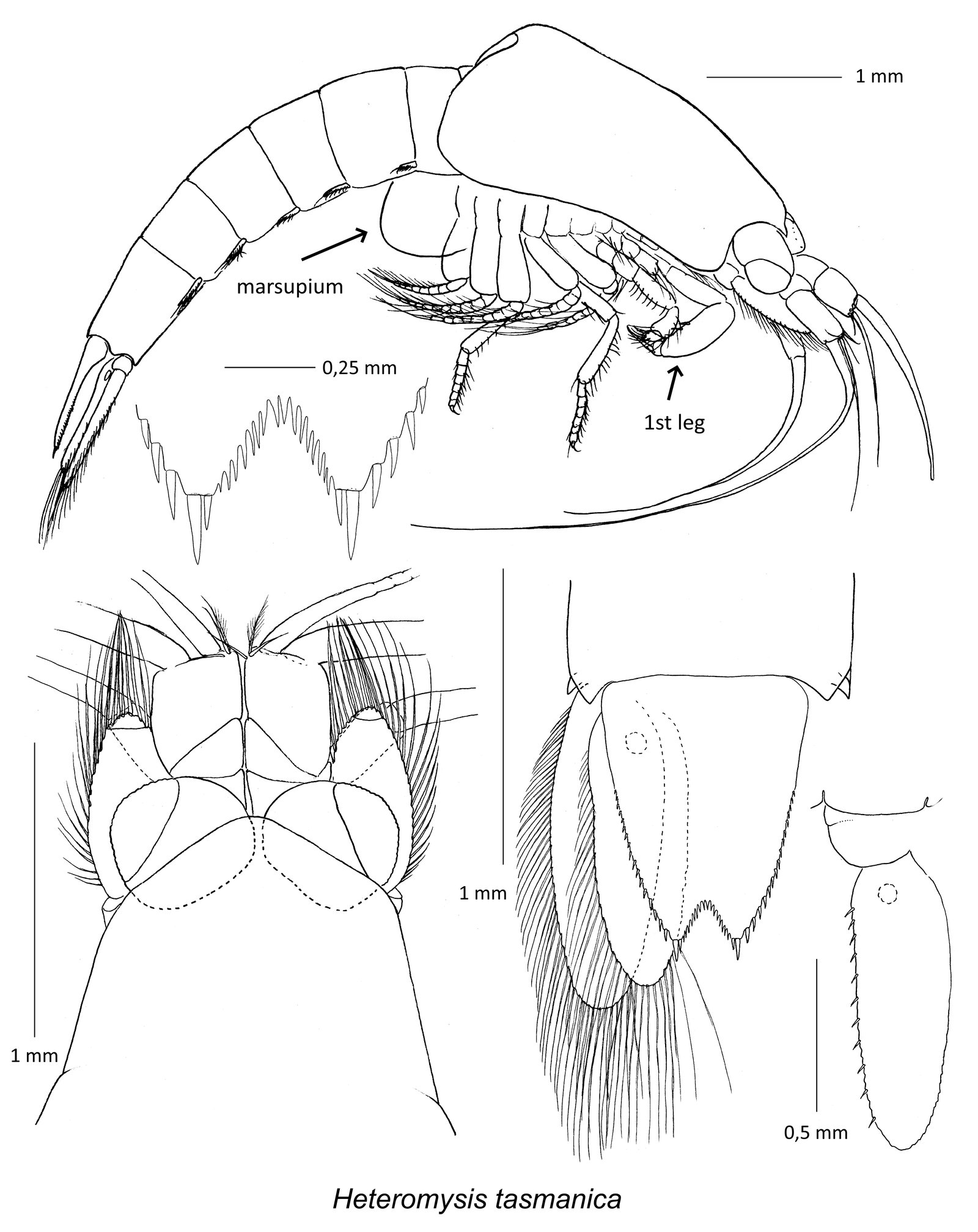Crustacean research: New fauna of commensal mysids discovered in New South Wales
In the new study exploring the Australian Museum Marine Invertebrate collections, a series of seven species of mysids associated with other marine invertebrates have been discovered in the coastal waters of NSW. Two species are new to science and are named after Stephen Keable and Anna Murray!
Mysids are small, graceful crustaceans commonly referred to as opossum shrimp. This analogy with marsupials comes from the presence of a pouch in females, where they carry fertilised eggs and embryos before offspring are released as minute versions of the adult. Mysids can be abundant and commonly form swarms, particularly near the sea floor. Due to their abundance, they are an important link in food webs and are also a traditional part of the human diet in East and South-East Asia. Along with other crustaceans, which require calcium carbonate to form their outer body covering or shell, mysids may be under threat from increased ocean acidity associated with climate change.

Heteromysis harpaxoides is a brightly colored commensal of the hermit crab Dardanus megistos.
Image: R. Springthorpe© Australian Museum
In 2015, mysid expert Mikhail Daneliya from Finland visited the Australian Museum Research Institute on an AMF/AMRI Visiting Collection fellowship to examine the Marine Invertebrates collection. Mikhail has recently published the second of his papers that report discoveries made during this visit, and this latest work deals with members of the subgroup Heteromysini.

Mikhail Daneliya during his visit to the Australian Museum Research Institute in 2015.
Image: Stephen Keable© Australian Museum
Mysids of the tribe Heteromysini (family Mysidae) are known to be associated with various coastal benthic invertebrates, like sponges, hydroids, corals and hermit crabs. Compared to other mysids, their anterior pair of walking legs have been transformed into a kind of specialised grasping organ, hence their name (from the Greek stem hetero- meaning different). Many species have been documented from the tropical seas of Australia, but their presence in the cool Tasman Sea was previously limited to one species from the Tasmanian coast and one tentatively identified species from Sydney Harbour.

Distribution of Heteromysis species within New South Wales.
Image: Mikhail Daneliya© Mikhail Daneliya
In the new study exploring the collections of the Australian Museum, a series of seven species, belonging to the genus Heteromysis, have been discovered in the coastal waters of New South Wales. Among them two species, H. keablei and H. murrayae, are new species to science, with the names dedicated to the collectors, Australian Museum marine invertebrate specialists Stephen Keable and Anna Murray.
Additionally, H. communis, associated with sponges, was previously known only from the Northern Territory coast, and H. tasmanica only from the hard sea bottom of Tasmania and southern Australia. Heteromysis macropsis was originally described from India, and this is the first time it has been reported in Australia. It is not yet clear what particular association with different substrates the species has, although in NSW it was found among brown algae, sponges, bryozoans and hydroids. Heteromysis abrucei is a widespread coral reef inhabitant in the Indian Ocean and tropical Australia, but its presence is now confirmed from various localities along the NSW coast. Heteromysis harpaxoides is a brightly colored commensal of the hermit crab Dardanus megistos. It mimics the crab’s red spines and is one of the most well-known heteromysids in Australia, having been recorded from the coral reef habitats throughout the tropical coast. Its discovery in NSW is rather surprising because the host crab is not well known here.

Taxonomic illustrations of Heteromysis tasmanica.
Image: Mikhail Daneliya© Mikhail Daneliya
Recognition of these mysids further south in NSW is significant as they have previously been considered tropical species. Other studies have shown that the East Australian Current has been increasingly bringing warm water from the Coral Sea, spreading tropical species further south. The new study contributes to understanding the origin and distribution of the Australian marine fauna and provides supporting evidence of the adaptability of the coral reef inhabitants to the conditions of climate change.
Dr Mikhail Daneliya, Visiting Scholar, Organismal and Evolutionary Biology Research Programme, University of Helsinki.
Dr Stephen Keable, Collection Manager, Marine Invertebrates, Australian Museum Research Institute.
More information:
- Daneliya, M.E., Price, W. & Heard, R. 2018. Revision of the Siriella brevicaudata species group (Crustacea: Mysida: Mysidae) from the West Indo-Pacific. European Journal of Taxonomy 426: 1-80. https://doi.org/10.5852/ejt.2018.426
- Daneliya, M.E., 2021. On the mysid crustacean genus Heteromysis (Mysidae: Heteromysinae) of the Tasman Sea, with notes on the tribe Heteromysini. Records of the Australian Museum 73 (1): 1-50. https://journals.australian.museum/daneliya-2021-rec-aust-mus-731-150/
- Australian Museum, Marine Invertebrates. https://australian.museum/learn/collections/natural-science/marine-invertebrates/
- Australian Museum, Awards and Fellowships.https://australian.museum/get-involved/amri/awards-fellowships/

